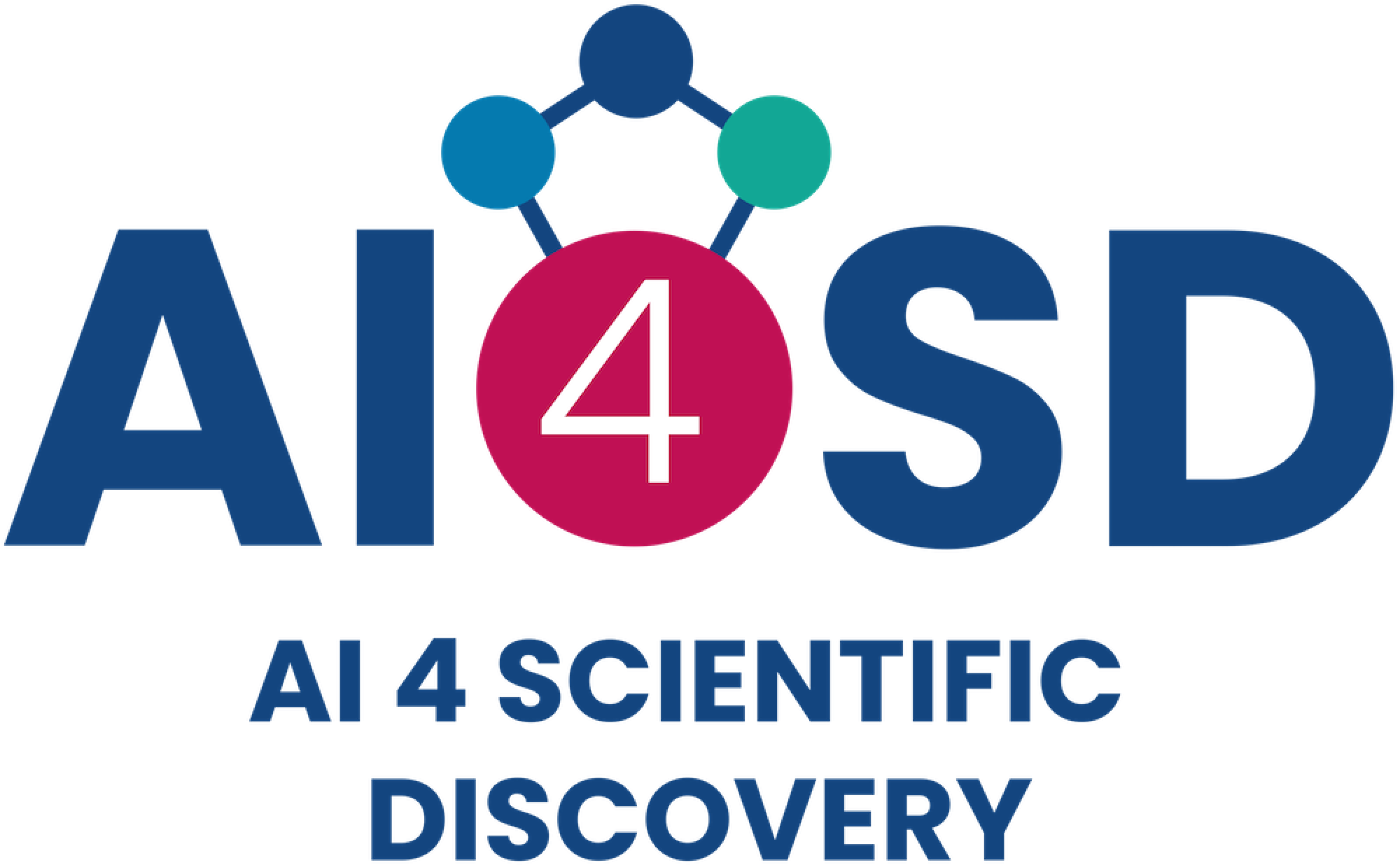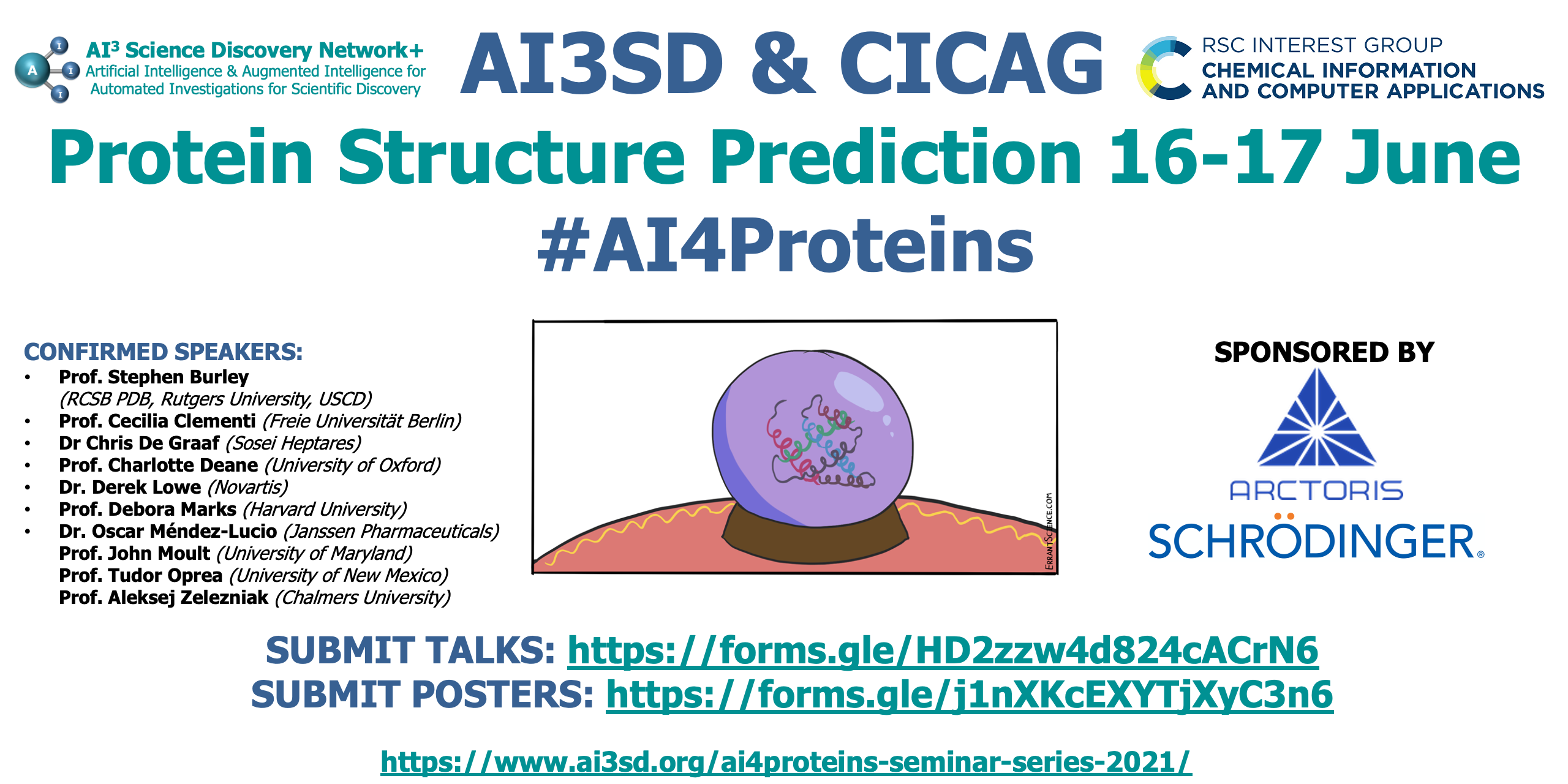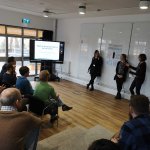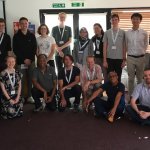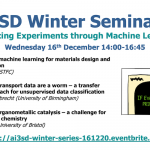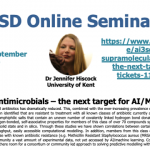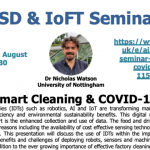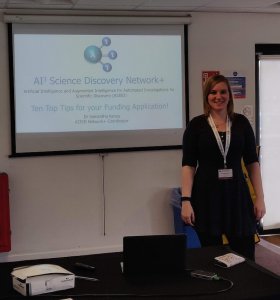This two day conference was the concludinging event to the the AI3SD and RSC-CICAG AI 4 Proteins Series. This seminar was hosted online via a zoom webinar and the event consisted of two talks on this subject. Below are the speaker biographies, and the full playlist of this seminar can be found here.
An AI solution to the protein folding problem: what is it, how did it happen, and some implications – Professor John Moult (University of Maryland)
John Moult is a Fellow at the Institute for Bioscience and Biotechnology Research and Professor in the Department of Cell Biology and Molecular Genetics at the University of Maryland. He is co-founder and Chair of CASP (Critical Assessment of Protein structure Prediction), an organization that conducts large-scale community experiments in protein structure modeling, and joint founder of CAGI, a sister organization for advancing genome interpretation. He is an ex-crystallographer turned computational biologist. His research interests include the relationship between genetic variation and human disease, disease mechanisms, protein structure, and different ways of doing science.
BSc Physics, University of London 1965
D.Phil Molecular Biophysics, University of Oxford 1970
Video Unavailable
So you predicted a protein structure – What now? – Dr Thomas Steinbrecher (Schrödinger)
Thomas Steinbrecher studied Chemistry at the University of Freiburg in Germany and earned a diploma with distinction in Physical Chemistry. He completed a Ph.D. thesis on “Computer Simulations of Protein-Ligand Interactions” in 2005. He joined the developer team of the Amber MD package as a Postdoc at the Scripps Research Institute in San Diego and Rutgers University in New Jersey. The work focus was on efficient free energy calculation methods and QM/MM simulations of charge transfer. After returning to Germany in 2008, Thomas established a junior research group at the Karlsruhe Institute of Technology, working on fast electron transfer phenomena in DNA and proteins. He joined Schrodinger in 2013 where he was responsible for the large scale application of free energy calculation methods in pharmaceutical drug design. Since 2017, he heads the Applications Science Department for Europe and supports customers in employing Schrödinger’s Drug Discovery Technology Platform for their research.
Deep Learning enhanced prediction of protein structure and dynamics –Dr Martina Audagnotto (AstraZeneca)
Martina completed her M.Sc. in Chemistry at the University of Turin, studying the effect of the adsorption of amino acids on titanium dioxide using quantum mechanics approaches. Afterwards, she pursued a PhD in the field of Molecular Dynamics at École Polytechnique de Lausanne (EPFL) under Prof. Dal Peraro’s supervision. Combing X-ray experiments and Molecular Dynamics simulations, Martina investigated the membrane-protein interplay in modeled physiological conditions. Her work highlighted the importance of applying a multilevel approach to achieve a comprehensive picture of biological systems and understanding the dynamic interactions and subsequent events that occur in cells. At the University of California San Diego (UCSD) under the supervision of Prof. Amaro, Prof. Villa and Prof. Taylor, Martina worked as a postdoctoral fellow on an interdisciplinary project to investigate the LRRK2 familial mutations and their association with Parkinson’s Disease. By combining in situ cryo-electron tomography (ET) density map with X-ray structure and homology models, she revealed the atomistic architecture of LRRK2 protein and their organization around the microtubule providing the starting point for future medicinal chemistry studies. Martina is currently working on proteins structure folding prediction methods at AstraZeneca in the team of Christian Tyrchan. By combining deep learning approaches with mechanistic modeling she retrieved not only the global experimental folding but also the experimental structural dynamics due to local and global conformational changes. Based on the insight of this study the proposing protocol will allow the in-silico investigation of protein dynamics suited for pharmacological research on catalysis and molecular recognition.
Fireflies-Lévy Flights algorithm for peptides conformational optimization –
Dr Zied Hosni (University of Sheffield)
Zied finished his PhD in the Cronin Group at the University of Glasgow before securing a postdoctoral position in the Bioinformatics Hub in the Centre for Virus Research in Glasgow. During his research experience, he developed the ability to apply his knowledge of computational chemistry and synthesis into practical use in drug discovery, including machine learning tools for polymorphism predictions, artificial intelligence solution development, big data technologies and virtual screening. Before coming to Sheffield, Zied was a research associate in the Centre of Computational Chemistry at Bristol University where he was investigating mechanistic insights of the stereoselectivity in boron-lithium chemistry. He was previously a research associate at Strathclyde Institute of Pharmacy and Biological Sciences at Strathclyde University (UK) where he fully utilised his machine learning for scientific projects, whilst collaborating with several global pharmaceutical companies such as Lilly, AstraZeneca and Novartis, providing the opportunity to liaise with industry professionals and experts.
How good are protein structure prediction methods at predicting folding pathways? – Mr Carlos Outeiral Rubiera (University of Oxford)
Carlos Outeiral was born and raised in northern Spain, where he completed his baccalaureate (achieving a National Award) and earned a BSc in Chemistry at the University of Oviedo (achieving the honours of valedictorian and extraordinary award). Following internships at the Technical University of Munich (Germany) and Harvard University (US), he completed a MPhil in Chemistry at the University of Manchester (UK). He is currently a final-year PhD candidate at the University of Oxford (UK), where his research studies novel algorithms to simulate protein folding at scale. Some of his work has examined the prospects of quantum computing in computational biology, and developed pipelines for biologically-inspired protein structure prediction. In his free time, Carlos is passionate about deep tech, entrepreneurship and open source software.
Protein-Ligand Structure Prediction for GPCR Drug Design – Dr Chris De Graaf (Sosei Heptares)
Dr. Chris de Graaf is Head of Computational Chemistry at Sosei Heptares, an international biopharmaceutical group focused on the design and development of new medicines originating from its proprietary GPCR-targeted StaR® technology and Structure-Based Drug Design platform capabilities (www.soseiheptares.com). In this role Chris is leading the development and application of structural cheminformatics and computer-assisted drug design approaches across the GPCRome to help Sosei Heptares advance a broad and deep pipeline of partnered and in-house drug candidates in multiple therapeutic areas including neurology, immuno-oncology, gastroenterology, inflammation and rare/specialty diseases.
Using icospherical input data in machine learning on the protein-binding problem – Dr Ella Gale (University of Bristol)
Ella Gale is currently the Machine Learning subject specialist attached to the Technology Enhanced Chemical Synthesis CDT in the School of Chemistry at the University of Bristol. Her current responsibilities include training the CDT students in machine learning, data science, statistics and design of experiments, providing data science and machine learning support to the chemistry department generally and researching machine learning techniques for retrosynthesis and de novo drug design. Dr Gale has has over ten years of experience working across artificial intelligence, computer science and chemistry.
Lessons learned from generative models of biological sequences – Professor Aleksej Zelezniak (Chalmers University of Technology)
Aleksej Zelezniak is a tenured Associate Professor, SciLifeLab fellow at the Chalmers University of Technology, Gothenburg, Sweden. He graduated MSc degree in Bioinformatics from the Technical University of Denmark with PhD at the European Molecular Biology Laboratory (EMBL) in Heidelberg, Germany developing network-based omics data integration methods for studying metabolic networks. For his postdoctoral training as an EMBO fellow, he joined the lab of Dr Markus Ralser at the University of Cambridge and the Francis Crick Institute, London, developing applications of machine learning to high-throughput mass spectrometry data. From 2017 he leads an independent research group developing machine learning approaches for de novo protein and DNA designs for biotechnology and synthetic biology applications.
DeepDock: a deep learning approach to predict ligand binding conformations – Dr Oscar Méndez-Lucio (The Janssen Pharmaceutical Companies of Johnson & Johnson)
Oscar got his PhD in Chemistry (cheminformatics) from the University of Cambridge in 2016. In 2017, he joined Bayer to apply deep learning to their research pipeline involved in the toxicity prediction. Currently, he is a scientist at Janssen Pharmaceuticals using artifical intlligence to automatically design molecules with improved potency and safety profiles. Oscar has published more than 40 scientific papers including some featured in Nature and Nature Communications.
Finding new in silico-based therapeutic strategies for IAHSP – Dr Matteo Rossi Sebastiano (University of Turin)
Born in Turin (Italy) 19.06.19902009: science high school diploma
2009-2015: Unique cycle master in Pharmaceutical sciences at the University of Turin (Italy), with a thesis integrating computational tools and wet lab techniques aimed to identify the dynamics of a protein-protein interaction and its pharmacologic inhibition. It led to the identification of two lead compounds against HER2+ breast cancer.
2015-2016: Worked as grant researcher at the Biomedizinsk Zentrum, Uppsala Universität (Sweden) with focus on molecular property calculation and chemical space definition for beyond the Rule of five compounds. It led to a milestone publication defining innovative polar surface areas as tool for permeability predictions of drugs in the beyond the Rule of five chemical space.
2016-2020: PhD in biomedical sciences at the Universität Bern (Switzerland) with a thesis investigating fatty acid metabolism in pancreatic ductal adenocarcinoma. Here I identified a key fatty acid-activator and several druggable downstream mechanisms at the crossover between tumor metabolism and immune resistance.
2020-present: Post-doc at the University of Turin (Italy) with focus on structural biology of Alsin, drug repurposing for neurological disorders and PROTAC® drugs chemical space definition.
Designing molecular models by machine learning and experimental data – Professor Cecilia Clementi (Freie Universität Berlin)
Cecilia Clementi is Einstein Professor of Physics at Freie Universität (FU) Berlin, Germany. She joined the faculty of FU in June 2020 after 19 years as a Professor of Chemistry at Rice University in Houston, Texas. Cecilia obtained her Ph.D. in Physics at SISSA and was a postdoctoral fellow at the University of California, San Diego, where she was part of the La Jolla Interfaces in Science program. Her research focuses on the development and application of methods for the modeling of complex biophysical processes, by means of molecular dynamics, statistical mechanics, coarse-grained models, experimental data, and machine learning. Cecilia’s research has been recognized by a National Science Foundation CAREER Award (2004), and the Robert A. Welch Foundation Norman Hackerman Award in Chemical Research (2009). Since 2016 she is also a co-Director of the National Science Foundation Molecular Sciences Software Institute.
The “almost druggable” genome – Professor Tudor Oprea (University of New Mexico)
Tudor Oprea is Professor and Chief, Translational Informatics Division, Department of Internal Medicine, UNM School of Medicine, Albuquerque, New Mexico (USA); and Guest Professor at the universities of Gothenburg (Sweden) and Copenhagen (Denmark). He holds an MD PhD from the University of Medicine and Pharmacy, Timişoara, Romania. Dr. Oprea co-authored over 260 publications, 10 US patents, and edited 2 books on drug discovery. His current research is to develop validated artificial intelligence models for target selection in drug discovery by combining numerical and text-mined information to model human health. Oprea serves as PI for the Illuminating the Druggable Genome Knowledge Management Center.
General Effects of AI on Drug Discovery – Dr Derek Lowe (Novartis)
I’ve been working in biopharma drug discovery since 1989 in a variety of therapeutic areas, and in recent years I’ve focused more on chemical biology. I’m currently a director with the Novartis (NIBR) Chemical Biology and Therapeutics organization. I’m also known for my web site, “In the Pipeline”, hosted at Science Translational Medicine, which is (I believe) now the oldest/longest-running science blog on the internet (since 2002).
Open Access Data: A Cornerstone for Artificial Intelligence Approaches to Protein Structure Prediction – Professor Stephen Burley (RCSB PDB, Rutgers University, UCSD)
Stephen Burley is an expert in structural biology, proteomics, data science, structure/fragment-based drug discovery, and clinical medicine/oncology. Burley currently serves as University Professor and Henry Rutgers Chair, Founding Director of the Institute for Quantitative Biomedicine, and Director of the RCSB Protein Data Bank at Rutgers, The State University of New Jersey. He is also a Member of the Rutgers Cancer Institute of New Jersey, where he Co-Leads the Cancer Pharmacology Research Program. From 2008 to 2012, Burley was a Distinguished Lilly Research Scholar in Eli Lilly and Co. Prior to joining Lilly, Burley served as the Chief Scientific Officer and Senior Vice President of SGX Pharmaceuticals, Inc., a publicly traded biotechnology company that was acquired by Lilly in 2008. Until 2002, Burley was the Richard M. and Isabel P. Furlaud Professor at The Rockefeller University and an Investigator in the Howard Hughes Medical Institute. He has authored/coauthored more than 300 scholarly scientific articles in top journals including Science, Science Advances, Cell, Molecular Cell, Structure, Nature, Nature Biotechnology, Nature Chemical Biology, Nature Genetics, Nature Methods, Nature Oncogene, Nature Scientific Data, Nature Structural and Molecular Biology, Nucleic Acids Research, Proceedings of the National Academy of Sciences, Journal of the American Chemical Society, Journal of Molecular Biology, PLOS Computational Biology, and Biochemistry and Molecular Biology Education. Following undergraduate training in physics and applied mathematics, Burley received an M.D. degree from Harvard Medical School in the joint Harvard-MIT Health Sciences and Technology Program and, as a Rhodes Scholar, received a D.Phil. in Structural Biology from Oxford University. He trained in internal medicine at the Brigham and Women’s Hospital in Boston and did postdoctoral work with Gregory A. Petsko at the Massachusetts Institute of Technology and Nobel Laureate William N. Lipscomb, Jr. at Harvard University. With William J. Rutter and others at the University of California San Francisco and Rockefeller, Burley co-founded Prospect Genomics, Inc., which was acquired by SGX in 2001. He is a Fellow of the Royal Society of Canada, the New York Academy of Sciences, and the American Crystallographic Association, and recipient of a Doctor of Science (Honoris causa) from his alma mater the University of Western Ontario, from which he received a B.Sc. in Physics in 1980.
